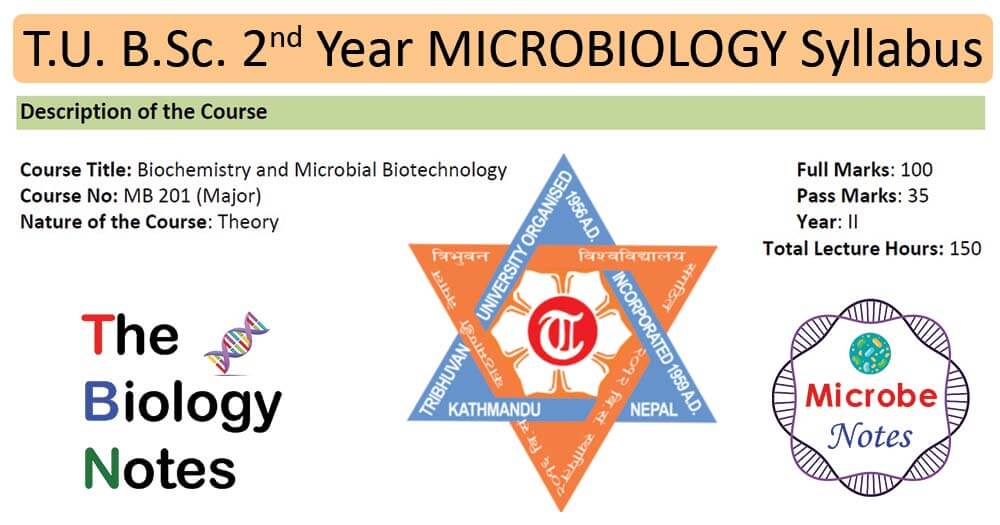
Description of the Course
Course Title: Biochemistry and Microbial Biotechnology
Full Marks: 100
Course No: MB 201 (Major)
Pass Marks: 35
Nature of the Course: Theory
Year: II
Total Lecture Hours: 150
Course Objectives
After completion of the course, the students will be able to:
a) understand cell and its functions, and macromolecules of living cells and their metabolism
b) understand the concept of biotechnology and genetic engineering and their applications
Course Contents
Living cell and understanding of its biochemical functions- 15 hrs
Origin of biochemistry and its relationship with other sciences, biochemical explanation of living things, the elements of life, chemical elements present in living organisms, organic compounds found in living cells, water: the solvent for life, cell biomembranes- structure and functions.
Macromolecules and biomolecules of living cells- 20 hrs
Introduction, functions, classification, structure, important properties ofcarbohydrates,amino acids,proteins,lipids, andnucleic acids
Enzymes: nomenclature, classification, functions of enzymes, co-enzymes, cofactor and isozymes, enzyme kinetics, factors affecting the regulation of enzymes.
Microbial metabolism- 20 hrs
Concept of exergonic and endergonic reactions, heterotrophic and autotrophic metabolism, the role of ATP intermediary metabolism, heterotrophic generation of ATP in various pathways of carbohydrate metabolism, lipid metabolism, protein metabolism.
Microbial genetics- 20 hrs
Structure, types, and functions of DNAandRNA,replication of DNA,transcription, andtranslation, regulation of gene expressions,lac operon,基因tic code.
Concept of biotechnology- 5 hrs
Definition and history, scope and importance, risk, and hazards of biotechnology.
Fermentation process- 15 hrs
Introduction, the固态发酵,submerged state fermentation, fermentation industries, beer, ethanol, acetic acids, fermentor designs.
Agricultural microbial biotechnology- 15 hrs
Introduction, biofertilizer and composting,植物组织培养,micropropagation, and disease-free plants, the general concept ofcell fusion, andembryo transfer.
Biotechnology in diary industry- 12 hrs
Milk and milk products: cheese, yogurt, ice-cream production, sour milk, skimmed milk, dry powder milk,pasteurization process of milk.
Methods in genetic engineering- 12 hrs
Introduction, the outline of基因cloning,基因cloning procedure,vectorsused inrecombinant DNA technology, applications, and possible hazards of genetic engineering.
Enzyme technology- 16 hrs
Introduction, source of enzymes, selection of the source of enzymes, the advantage of microbial enzymes, production and purification of protease, amylase, chitinase, and pectinase.
Textbooks
1. Nelson DL and Cox MM (2004). Lehninger Principles of Biochemistry, 5th Edition. Freeman Publication.
2. Stryer L (1995). Biochemistry, 4th Edition. W.H. Freeman Company, New York.
3. Creuger W and Creuger A (2000). Biotechnology. A textbook of Industrial Microbiology. Sinaeur Associates.
4. Smith JE (1996). Biotechnology, 3rd Edition. Cambridge University Press.
5. Cassida LE Jr (1996). Industrial Microbiology, New Age Int. Publishers.
Reference books
1. Rao KR (1986). Textbook of Biochemistry, 3rd Edition. Prentice-Hall of India.
2. Rao RAVSS (1993). A Textbook of Biochemistry, UBSPD Co.
3. Jain JL (2004). Fundamentals of Biochemistry. S Chand and Company Ltd.
4. Dubey RC (2001). Textbook of Biotechnology. S Chand and Company Ltd.
Description of the Course (Practical)
Course Title: Biochemistry and Microbial Biotechnology
Practical Full Marks: 50
Course No: MB 202 (Major)
Pass Marks: 20
Nature of the Course: Practical
Year: II
Total Lecture Hours: 180
Course Objectives
After completion of the course, the students will be able to:
a) develop practical skills in preparing solutions, buffers, and qualitative and quantitative estimates of biomolecules and basic biotechnological laboratory skills.
Course Contents
To prepare solutions of different concentrations
Molar solutions, normal solutions, ppm (part per million) solutions.
To prepare buffer solutions
Measurement of pH using pH meter and indicators, preparation of acetate, phosphate, and citrate buffers of different pH.
To perform a qualitative and quantitative estimate of various types of carbohydrates
Benedict test(for reducing sugars), Molish’s test, Barfoed’s test, Seliwanoff’s test, hydrolysis test (for di and polysaccharides), iodine test for starch, quantitative estimation of reducing sugars by DNS (3,5 dinitrosalicylic acid method), extraction of glycogen from the liver.
To estimate lipids
Determination of the value of fat, saponification value of fat, iodine number of fat, estimation of blood cholesterol level.
To estimate amino acids and protein
Ninhydrin reaction,biuret reaction, xanthoproteic reaction, casein test in milk, test for tyrosine, tryptophan, and arginine, test for sulfur-containing amino acids, Heat coagulation test for egg albumin.
To analyze different enzymes activities
Amylase, sucrase, carboxylase, protease, lipase, phosphatase, lactase.
To use different instruments and techniques for biochemical analysis
Separation and identification of amino acids by paper electrophoresis, separation and identification of sugars and lipids bythin-layer chromatography (TLC), separation and identification of amino acids bypaper chromatography, separation of amino acids by single and double ascending paper chromatography, chicken liver fractionation by differential centrifugation, analysis of protein bySDS-PAGE.
To detect microorganisms from various plants and their products
Rhizobium inoculation in different leguminous plants, isolation, and characterization ofRhizobium, Azotobacter, andMycorrhiza.
Screening of microorganisms and production of fermented products
Screening of wine yeasts, production of alcohol, kinema, estimation of fermentation yield by substrate variation method.
Extraction, purification, and estimation of enzymes
Amylase and protease enzymes of bacteria.
Isolation of bacteria
Methanogenic bacteria from rumen and compost;actinomycetes from compost and soil.
Reference
Tribhuvan University.Institute of Science and Technology. 4 year’s Bachelors of Science Revised Course of Study. Dean’s Office, Kirtipur, Kathmandu, Nepal.

